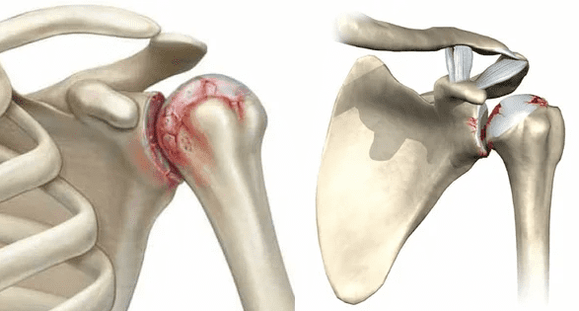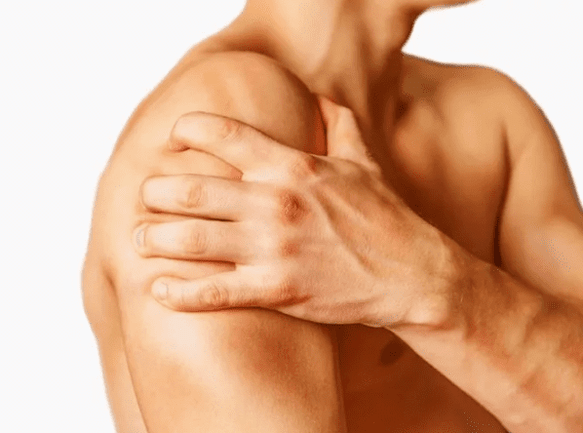Osteoarthritis of the shoulder joint is a chronic disease based on damage to cartilage tissue, followed by the appearance of bone growth and limited mobility. Older people often suffer, but heavy physical labor and inflammatory processes contribute to the early development of pathology. Without timely treatment, movements in the affected joint are completely blocked.

General Information
Cartilage is a smooth layer between the contact areas of the bones. Provides easy sliding relative to each other, guarantees free and painless joint work. Excessive stress, inflammation or trauma can trigger a degenerative process that gradually spreads to the entire surface.
As a result, the smoothness of the joint surfaces is disturbed and the movements cause pain. At the same time, bone growths begin to appear along the edges of the joint, which replaces the affected cartilage. As the degenerative process progresses, it affects not only the bones but also the surrounding tissues. The extremity deforms, the muscles spasm, and the ligaments weaken and lose their elasticity. Without treatment, a person loses the ability to move the arm.
Views
Primary and secondary osteoarthritis differ depending on the cause of development. The primary form occurs spontaneously, often against the background of overload of the joint. Secondary third-party pathology, such as trauma, severe inflammation, metabolic diseases, etc. Both forms of the disease are similar in symptoms.
Reasons
Unlike the knee, ankle and hip joints, the shoulder does not experience significant stress when walking, so this form of osteoarthritis is less common. May cause pathology:
- regular extreme physical activity: weight lifting, professional sports, vibration;
- congenital anomalies of the shoulder joint and adjacent structures;
- rheumatoid arthritis, systemic lupus erythematosus and other autoimmune diseases;
- congenital weakness of the connective tissue accompanied by hypermobility of the joints;
- injuries: dislocations, sprains and ligaments, intra-articular bone fractures;
- hormonal changes and disorders (including pregnancy, menopause);
- inflammatory diseases of the joint and periarticular structures (arthritis, bursitis, etc. );
- Metabolic diseases, including gout, diabetes mellitus.
Heredity plays an important role in the predisposition to osteoarthritis.
Degrees
Doctors prescribe 3 degrees of deformed arthrosis, which determine the symptoms of the shoulder joint and the choice of treatment tactics:
- Grade 1 is characterized by minimal manifestations: the pain occurs only with a strong or prolonged force and passes rapidly after rest, and X-rays reveal subchondral sclerosis of the articular surfaces;
- With grade 2 osteoarthritis, the pain is so intense that a person has to use painkillers to feel better; radiography shows an open narrowing of the joint space, extensive areas of cartilage destruction and bone growths (osteophytes);
- Grade 3 disease is accompanied by persistent intense pain, significantly limited joint mobility, and the figure shows complete destruction of cartilage tissue, deformity of bone structures, and numerous osteophytes.
Symptoms
The main symptoms of shoulder osteoarthritis include:
- pain: caused by a decrease in the smoothness of the articular surfaces, the growth of osteophytes and bone deformities; the intensity, duration and nature of the feelings depend on the degree of damage;
- crisis: one of the characteristic symptoms of the disease, which appears in the early stages; differs from physiology by a more pronounced tone, and at the same time is often accompanied by pain;
- restriction of mobility: associated with the appearance of pathological growths and destroyed cartilage particles inside the joint; in the early stages, it is represented by a slight morning stiffness, then grows to immobility (ankylosis);
- Deformation: changes in the contours of the joint, then the hand, occur in the later stages of the disease and indicate the complete destruction of cartilage and the involvement of bones, muscles and ligaments in the pathological process.
The progression of symptoms can last for years, even decades, but as a result, osteoarthritis of the shoulder joint causes the arm to become immobile and severe pain.

Diagnostics
The diagnosis of osteoarthritis of the shoulder joint requires an integrated approach. To accurately diagnose and determine the extent of the lesion, the doctor uses the following methods:
- Anamnesis survey and collection: the patient's complaints are recorded, the conditions of occurrence of certain symptoms are determined; information on past illnesses and injuries, joint damage to parents is clarified;
- examination: the doctor visually assesses the joint, the degree of movement, the area of greatest pain, etc. identifies;
- X-rays and CT: the main diagnostic method that allows to see the characteristic symptoms of osteoarthritis (narrowing of the joint space, cartilage failure, bone growth and deformities);
- Ultrasound: allows you to assess the condition of cartilage, bones, ligaments, joint capsule and muscles;
- MRI: allows to obtain virtual slices of all structures of the affected area;
- laboratory diagnosis: blood test detects an active inflammatory process accompanied by osteoarthritis;
- arthroscopy: to examine the joint from the inside with a camera inserted into a small hole.
If the disease is secondary, examination and consultation with specialists on the underlying pathology is mandatory.
Treatment of shoulder arthrosis
Treatment of osteoarthritis of the shoulder joint depends on the degree of the lesion: in stages 1 and 2, the disease can be successfully stopped or postponed by proper selection. The only way to restore mobility with a wide destruction and completely stop the pain is a surgical operation - arthroscopy with "cleaning" of the joint.
Drug treatment
Medical treatment for shoulder arthrosis focuses on reducing symptoms and restoring cartilage tissue. The following groups of drugs are used for this purpose:
- non-steroidal anti-inflammatory drugs: prevent inflammatory reactions and reduce pain; available in tablet, ointment, suppository and injection form;
- hormonal agents (corticosteroids): used when NSAIDs are ineffective, have a similar effect; a good effect is provided by long-acting drugs injected directly into the joint cavity;
- antispasmodics, B vitamins: used to reduce muscle spasms, which are necessarily accompanied by advanced arthrosis;
- chondroprotectors: intended for long-term use aimed at the regeneration of cartilage tissue;
- Drugs that improve microcirculation: indirectly stimulate regeneration processes by improving blood supply to the affected area;
- Enzyme blockers: partially slow down the destruction of cartilage tissue.
The choice of specific drugs, dosage, frequency of application and duration of the course is carried out only by a doctor! It is important to remember that self-medication can cause accelerated joint degeneration and other side effects.
Physiotherapy
Physiotherapy techniques and physiotherapy exercises greatly facilitate the course of the disease and increase the effectiveness of drugs. The following procedures have been shown to have a good effect:
- magnetotherapy: relieves pain, eliminates inflammation, improves microcirculation and stimulates the regeneration of cartilage tissue;
- shock wave therapy: exposure to acoustic waves of a certain frequency helps to destroy osteophytes that facilitate movement in the affected joint;
- electrophoresis, phonophoresis: application of drugs (painkillers, chondroprotectors) to tissues using electrical impulses or ultrasound; promotes better assimilation of drugs;
- massage and physiotherapy exercises: dose loads on the joints and intense hand movements stimulate blood circulation in the tissues.
Like medications, physiotherapy, massage and exercise therapy should be prescribed and performed under the supervision of a specialist. If they are useful in a quiet period, the effect on the background of an acute inflammatory process can lead to increased pain.
Surgery
The final stage of shoulder osteoarthritis is accompanied by severe symptoms and requires surgical treatment. Most of the changes that occur as a result of degeneration are irreversible, so the only way for a person to regain mobility is through endoprosthetics. It is replaced by a modern prosthesis that completely assumes the functions of the affected joint. This operation is especially effective at a young and middle age, because it allows you to live without pain for years.
Prophylaxis
As with any joint disease, osteoarthritis of the shoulder is easier to prevent than to treat. Orthopedists recommend the following rules:
- exclude or minimize occupational risk factors (vibration, weight lifting);
- not to allow hypodynamics, but also not to work for sports notes: it is better to choose a training option in moderation;
- to control nutrition and weight;
- get regular checkups to identify possible problems.
Diet
It is important to follow a diet with shoulder arthrosis to any degree:
- avoid overeating and being overweight;
- minimize harmful products: fatty, spicy, salty, alcoholic beverages, canned food, smoked meats;
- eat enough foods with collagen (mixed meat, aspic) and omega-3 (oily fish, olive oils);
- prefer boiled, steamed or cooked foods to fried foods;
- reduce the amount of fast-digesting carbohydrates.
The diet should be complete and include the right amount of vitamins, minerals and nutrients.
Consequences and complications
Even a slight pain and crisis in the shoulder can turn into unpleasant consequences. Without treatment, osteoarthritis causes:
- significant restriction of mobility up to ankylosis (bone fusion);
- severe pain at rest;
- severe deformation of the shoulder and the whole arm.
To avoid these problems, you do not need to search the Internet for folk remedies for osteoarthritis of the shoulder joint, just contact an orthopedist for a therapy option.
Treatment in a private clinic
Osteoarthritis cannot be treated alone. Specialists of modern clinics offer patients complex methods of treatment of shoulder arthrosis:
- modern drug therapy regimens that combine high efficacy and minimal side effects;
- time testing and new physiotherapy techniques;
- PRP therapy;
- physiotherapy exercises and massage to overcome joint movement restrictions.
If necessary, medical puncture of the joint is performed with the use of analgesics or artificial synovial fluid to facilitate movement.
We monitor the patient throughout the treatment to control the disease.
Advantages of modern clinics
Offers special knives to patients:
- comprehensive health screening programs;
- advanced examinations for accurate diagnosis;
- consultations of narrow specialists of different profiles;
- modern treatment regimens, including not only medications, but also physiotherapy, massage and exercise therapy;
- reasonable prices for all services.
Osteoarthritis of the shoulder is a problem that can completely change a person's life. Do not allow the disease to progress to an irreversible stage, come to consult an orthopedist.



































